*This article is part of Arts Help's Art Theory series.
Allegory is used in art to illustrate an abstract concept or idea represented as a tangible subject, traditionally a human figure. Like a reverse metaphor, the subject is a stand-in for a concept, a feeling, or a state of mind: in literature, the writer might say “youth is a sunny day”; in art, the sunny day represents youth. By using a variety of symbols and semiotics to express one broad notion, the purpose of allegory is to touch on a unified experience and enlighten the viewer to the multitude of object associations, making philosophical or emotional concepts more easily recognizable.
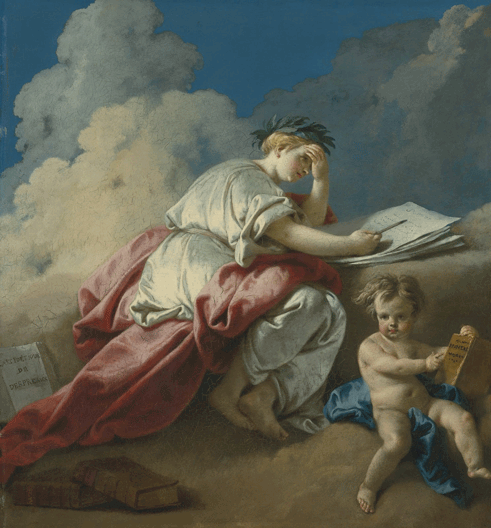
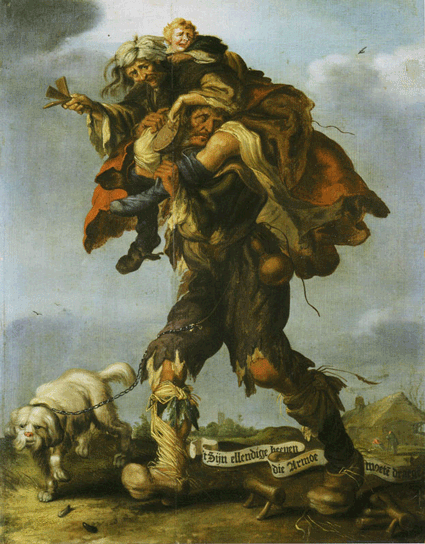
Distinguished by the highly subjective interpretations and illusive meanings that maintain an open-endedness to the discussions of the work, allegory in art separates itself from more specified styles of representational painting. Popularized in Western art from the early Renaissance to the Romantic era, allegorical art revolutionized the traditional tableau, employing conventional methods of storytelling in art such as gesture and iconography, to convey a more universal narrative. Like all tableaus, those of allegory present a moment of high drama frozen in time, usually mid-action and with several interwoven symbols to illustrate a narrative. The allegorical tableau, however, is differentiated for its philosophical, personal, or fabulistic storytelling – unlike the history paintings of the Neoclassical era, in which signifiers were used to establish an indisputable political or religious event. The ambiguity of allegorical paintings is precisely the reason for their mass appeal. The insight offered through a strongly observant narrative or system of images in allegorical art touches on a fundamental aspect of the human experience. The following are two examples of time-honoured allegory paintings from the era known as the height of figurative allegory in art.
Artemisia Gentileschi and the Allegory of Painting
Italian Renaissance painter Artemisia Gentileschi, perhaps the most famous female painter of her time, was well-known not only for her mastery of oil painting, but also for the boldness of her content and her willingness to challenge the world of academic art.
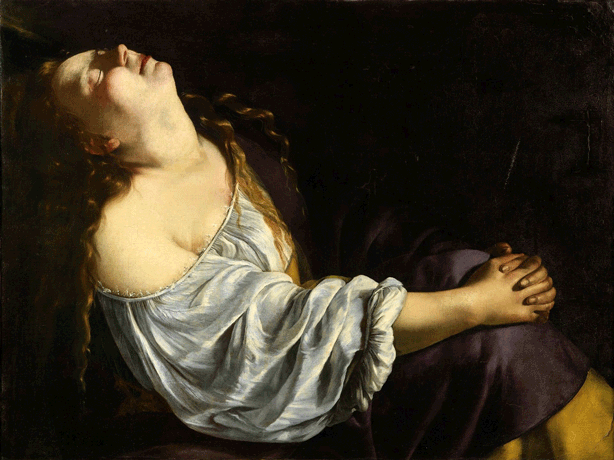
During a period from 1638 to 1641, Gentileschi was invited by Charles I to live and work in London alongside her artist father Orazio Gentileschi; it was there that she created one of the cardinal works of feminist art, Self-Portrait as the Allegory of Painting (1638-1639). Using the Iconologia, the societally agreed-upon reference guide to emblems and personifications, Gentileschi made use of her similar appearance to the allegory of Painting to create her double portrait, that of herself and of painting personified. Often used by artists when commissioned to paint portraits or allegorical paintings, the Iconologia describes Painting as, “a beautiful woman, with full black hair, dishevelled, and twisted in various ways, with arched eyebrows that show imaginative thought, the mouth covered with a cloth tied behind her ears, with a chain of gold at her throat from which hangs a mask, and has written in front ‘imitation.’” The inscription, mask, and mouth-covering are intentionally left out of Gentileschi’s portrait, perhaps in a statement of intentionality.
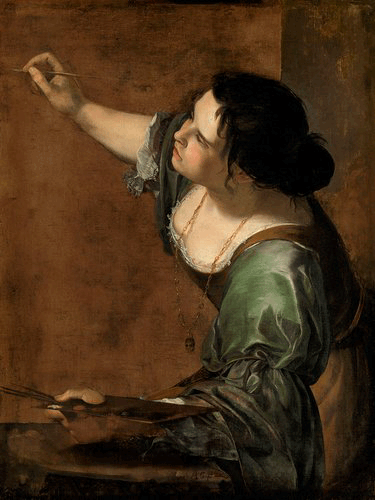
To conflate the image of oneself with the allegory of Painting was something that her male counterparts by iconographic definition could never do, and while this kind of emboldened artistic statement may have been distressing for some, Gentileschi enjoyed a great deal of success and financial interest due to her exceptional skill and her daring approach to art. Gentileschi’s portrait, as with much of her work, is not only audacious, but exemplary for the level of sophistication; the subject is unglamorous when depicted in the throes of painting, her apron covers her green dress and she appears to be in mid-action, beginning to form an image on a primed canvas. The angle at which she leans into the frame may have required two or more mirrors propped up beside her for visual reference, as the anatomical degrees of this pose would require a great deal of skill to hone, even if using a model. The level of expertise with which the painting was created along with the intense focus portrayed by the actions of the subject are referential of the subject as the embodiment of art itself, the personified allegory of Painting.
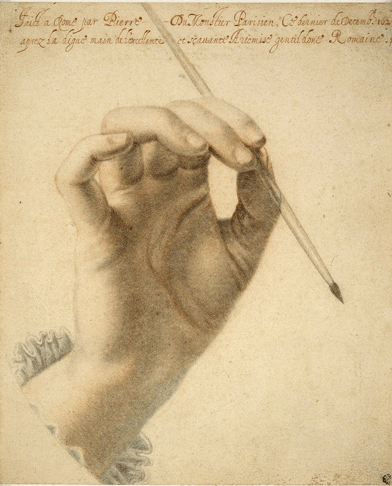
Pieter Bruegel the Younger and The Alchemist
A less personal and more didactic example of allegory is Pieter Bruegel the Younger’s masterpiece, The Alchemist (1600), a narrative scene allegorical of greed painted after the drawing of the same name by his father Pieter Bruegel the Elder.
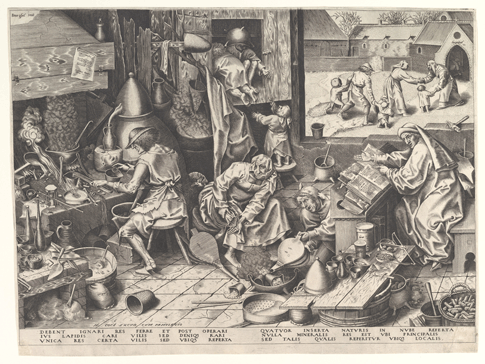
The narrative here warns the viewer of the pitfalls of greed and of preoccupation with obtaining unearned wealth. The notion of alchemy had already been discredited by the time this painting was created, but from the 15th to the 17th century, the supposed scientific practice of turning base metals into gold and silver was a commonly sought-after skill. The ongoing belief in its remote possibility was often exploited by con-artists and led to the undoing of those intent on realizing its potential. In typical allegorical paintings of alchemy, a scientist or scholar sits at a lectern, indicating the requisite study in order to make alchemy possible. Breugel’s incredibly detailed painting depicts a man sitting at such a lectern casting his hand toward the scene as a meta reference to the narrative played out before both him and the viewer.
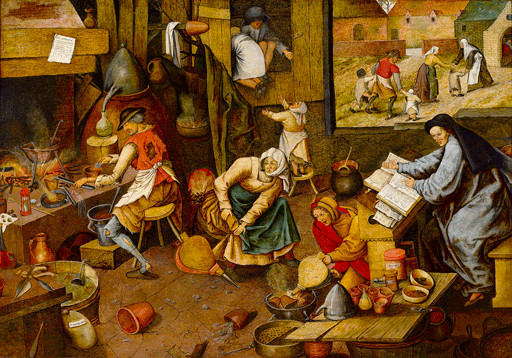
Another man sits at his makeshift laboratory, scientific tools and equipment haphazardly strewn across the table as he mixes elements into a bowl, trying to uncover the chemical recipe to produce the Philosopher’s Stone, that which would make alchemy possible. His wife sits nearby, holding out her empty coin-purse, indicating that every last piece of gold has been squandered in their attempts to achieve a short-cut to wealth. The children play unattended in the background, and the Fool, the apparent assistant to the would-be alchemist, blows air from a bellows onto a pot of coals, feeding the flames both literally and figuratively. The prophetic vision of what is to come for this family takes place outside as seen through the window. A family is portrayed begging for charity and being taken into a church or poorhouse. The narrative sequence of events here is similar to that of a folktale: simple and moralistic, and wholly indicative of the concept of folly and greed as allegorically represented by the visual story of the Alchemist’s downfall.
For its depth of possibilities, the allegorical analysis of art has been maintained as a leading methodology in art critique. As with storytelling, the nuances of meaning are often more thoroughly realized when representing meaning through the analogical use of allegory. Subtle delineations of insight or wisdom are given opportunity to be gleaned by the viewer, rather than presenting the meaning as explicitly informational. The cryptic essence of an allegorical work is pleasing for the challenge it offers; by imparting messages through fully subjective representation, the opportunity for variation allows access to perspectives from which the viewer may otherwise not see.
